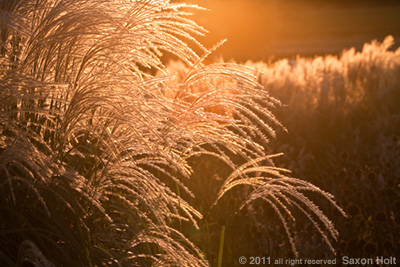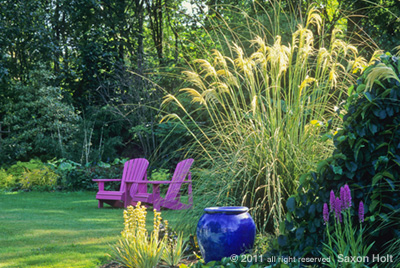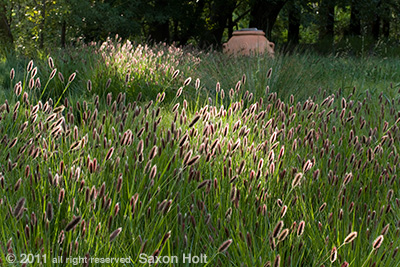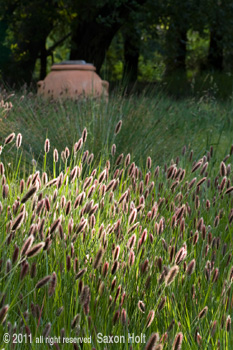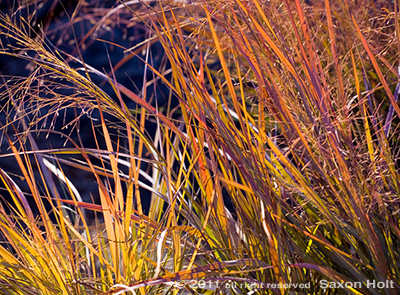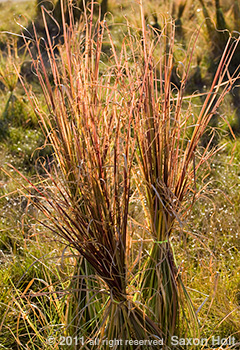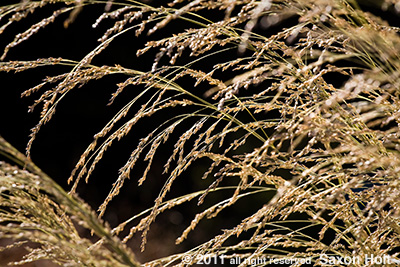Now that September has arrived I start looking at the grasses. Or rather, they grab me.
Grasses grab the light and reveal the sun. They dance in the wind; they rustle and whisper. By this time of the year their flowers have become seed heads beckoning the birds. With such dynamic inspiration on so many levels, grasses should grab any photographer to grab the camera and go out to grab some fun.
It’s a great time to break some camera rules and play with light and contrast. The best photos will come from finding a dark, shady area in the garden to be the background for bright high-key, back-lit grasses. I sometimes like shooting almost straight into the sun allowing for some lens flare to create mood. This often washes out some of the dark areas and blurs the highlights as in the first photo, but the effect is exciting.
A lens shade will suppress the flare, as in the next photo: same grass from the same spot. Both photos reveal the light and some of the character of Miscanthus sinensis ‘Malepartus’.
.
Carefully composed in the garden and then with the camera, flowering grasses almost require back light to “see” their glory. They work their magic any time of the year once they reach full flower, from summer to fall and into winter, where they can be the most dramatic element in a colorless garden. When sunlight outlines their culms and glumes, gardens sparkle.
Ever since I worked with Nan Ondra on our Grasses book back in 2001 I have looked for opportunities to use grasses to bring sunlight into my garden pictures. I can almost trace back that awakening to this exact picture in the wonderful garden of Linda Cochran.
The strategically placed specimen of Toe Toe grass (Cortaderia richardii) at the end of a garden bed allowed for this grass to light up the whole garden from various vantage points throughout the day. The 10′ tall flowering spikes find the sun and harvest the light all day long.
Other times sunbeams themselves can be revealed as they stream into a garden, spotlighting next a groundcover lawn alternative of Pennisetum massiacum ‘Red Bunny Tails’ in a garden designed by John Greenlee.
Depending on how the photographer composes the frame we can see the whole sunbeam or just the spotlight.
The photographer also has to be aware of proper exposure so that there is good detail in the bright, highlight areas and for the dark areas go dark enough to set off the backlit grass. This often means underexposing the meter setting, which takes an “average” light reading. For simple cameras without manual controls, there is usually a plus + or minus – control on the ISO setting. I would try at least one full stop minus; often it will take two.
For some grasses, the foliage itself can make a dramatic study in back light. Some of the most magical color in the garden comes from the sun shining through foliage – think of the glow of tree leaves back-lit in autumn as the sun streams through a cathedral wood. Nature’s inspiration for stained glass is the joyous color of transparent sunlight.
One of the wonderful grasses for fall foliage: Love grass, Eragrostis elotti.
Next we see Vetiver Grass (Vetiveria zizanoides) which has been tied in bundles so it won’t flop over, leaving these towers here and there in a meadow garden for the sun to paint.
Now is the time to find these photo compositions with light and line, to let shapes create the contrast and glow. Remember to always try and fill your frame with meaningful elements – and let the sun shine in.
Here is a gallery of more photos on my PhotoBotanic Archive. Grasses – Backlit. Now go have some fun with your own camera.

